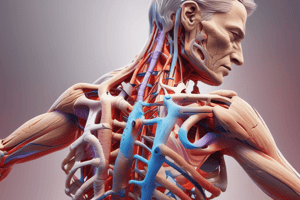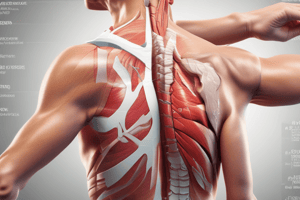Podcast
Questions and Answers
What is the purpose of the tangential projection of the shoulder using the Neer method?
What is the purpose of the tangential projection of the shoulder using the Neer method?
- To evaluate the humeral head alignment
- To assess the acromion and coracoid processes
- To demonstrate the supraspinatus outlet region for possible shoulder impingement (correct)
- To visualize the entire scapula structure
What should be visible in the tangential projection of the shoulder using the Neer method?
What should be visible in the tangential projection of the shoulder using the Neer method?
- The entire humeral head in the center of the glenoid fossa
- Superimposition of the humeral head over the supraspinatus outlet region
- Clear visualization of the entire scapula without any superimposition
- Proximal humerus superimposed over the thin body of the scapula without rib superimposition (correct)
What is the recommended patient position for obtaining the tangential projection of the shoulder using the Neer method?
What is the recommended patient position for obtaining the tangential projection of the shoulder using the Neer method?
- Standing position with arms raised
- Erect or recumbent position (correct)
- Lying on the unaffected side
- Sitting position with back support
What is the warning associated with the tangential projection of the shoulder using the Neer method?
What is the warning associated with the tangential projection of the shoulder using the Neer method?
What is the recommended caudal angle for the Neer method in shoulder trauma imaging?
What is the recommended caudal angle for the Neer method in shoulder trauma imaging?
What is the patient position for the scapular Y lateral in shoulder trauma imaging?
What is the patient position for the scapular Y lateral in shoulder trauma imaging?
Where should the CR be directed for the scapular Y lateral in shoulder trauma imaging?
Where should the CR be directed for the scapular Y lateral in shoulder trauma imaging?
What is the purpose of the routine technique for shoulder trauma imaging?
What is the purpose of the routine technique for shoulder trauma imaging?
Where should the CR be directed for the AP (neutral rotation) in shoulder trauma imaging?
Where should the CR be directed for the AP (neutral rotation) in shoulder trauma imaging?
What is the recommended body obliquity for the scapular Y lateral in shoulder trauma imaging?
What is the recommended body obliquity for the scapular Y lateral in shoulder trauma imaging?
What is the recommended collimation for the mentioned shoulder trauma imaging techniques?
What is the recommended collimation for the mentioned shoulder trauma imaging techniques?
In which position can the patient be placed for the AP (neutral rotation) in shoulder trauma imaging?
In which position can the patient be placed for the AP (neutral rotation) in shoulder trauma imaging?
What is the evaluation criteria for the scapular Y lateral in shoulder trauma imaging?
What is the evaluation criteria for the scapular Y lateral in shoulder trauma imaging?
What are some clinical indications for shoulder trauma imaging?
What are some clinical indications for shoulder trauma imaging?
Where should the projection pass through for the Neer method in shoulder trauma imaging?
Where should the projection pass through for the Neer method in shoulder trauma imaging?
What is the recommended range of body obliquity for the scapular Y lateral in shoulder trauma imaging?
What is the recommended range of body obliquity for the scapular Y lateral in shoulder trauma imaging?
What is the recommended SID for a nontrauma shoulder routine radiograph?
What is the recommended SID for a nontrauma shoulder routine radiograph?
How should the patient be positioned for a nontrauma shoulder routine radiograph?
How should the patient be positioned for a nontrauma shoulder routine radiograph?
Where should the central ray (CR) be directed for an internal rotation lateral view of the shoulder?
Where should the central ray (CR) be directed for an internal rotation lateral view of the shoulder?
What is the purpose of performing a nontrauma shoulder routine radiograph?
What is the purpose of performing a nontrauma shoulder routine radiograph?
In which position should the arm be for an internal rotation lateral view of the shoulder?
In which position should the arm be for an internal rotation lateral view of the shoulder?
What is the minimum recommended IR size for a nontrauma shoulder routine radiograph?
What is the minimum recommended IR size for a nontrauma shoulder routine radiograph?
What is the purpose of collimation in shoulder radiography?
What is the purpose of collimation in shoulder radiography?
What should be visualized to confirm a full internal rotation position in a shoulder radiograph?
What should be visualized to confirm a full internal rotation position in a shoulder radiograph?
What is the purpose of performing an external rotation (lateral) view of the shoulder?
What is the purpose of performing an external rotation (lateral) view of the shoulder?
What should be visualized to confirm a full external rotation position in a shoulder radiograph?
What should be visualized to confirm a full external rotation position in a shoulder radiograph?
What is the purpose of shielding in shoulder radiography?
What is the purpose of shielding in shoulder radiography?
Study Notes
Shoulder Trauma Imaging Techniques
- The Neer method is used for special supraspinatus outlet shoulder trauma imaging
- Neer method requires a 10° to 15° caudal angle for the CR, and the projection passes through the superior margin of the humeral head
- The routine technique for shoulder trauma imaging includes aP (neutral rotation) and Scapular Y lateral
- For the scapular Y lateral, the patient is positioned in an anterior oblique position, with the amount of body obliquity ranging from 45° to 60°
- The CR for the scapular Y lateral is perpendicular to the IR, directed to the scapulohumeral joint
- The evaluation criteria for the scapular Y lateral include demonstrating a true lateral view of the scapula, proximal humerus, and scapulohumeral joint
- Clinical indications for shoulder trauma imaging include fractures or dislocations of the proximal humerus and shoulder girdle, as well as calcium deposits in muscles, tendons, or bursal structures
- The routine technique for shoulder trauma imaging also includes an AP (neutral rotation) and Transthoracic lateral
- For the AP (neutral rotation), the CR is directed to the midscapulohumeral joint, approximately 3/4 inch (2 cm) inferior and slightly lateral to the coracoid process
- The patient position for the AP (neutral rotation) is either erect or supine, and the body is rotated slightly toward the affected side if necessary
- The CR for the AP (neutral rotation) is perpendicular to the IR, directed to the midscapulohumeral joint
- Collimation on four sides is recommended for all the mentioned shoulder trauma imaging techniques
Studying That Suits You
Use AI to generate personalized quizzes and flashcards to suit your learning preferences.
Description
Test your knowledge of shoulder trauma imaging techniques with this quiz. Challenge yourself with questions about the Neer method, scapular Y lateral positioning, and evaluation criteria for shoulder trauma imaging.




